
Bharat Motor Repairing Works
‘The Bharat Motor Repairing Works’, reads the dusty lopsided board hung outside the workshop in Lal Kuan, Old Delhi. One of the last few karkhanas of kherad ka kaam on metals that is still located in the old city of Delhi, the workshop in its dilapidated condition provides a fascinating glimpse into the industrial history of Delhi. The board also identifies them as 'automobile engineers': though not formally trained, they are tremendously adept at their work.
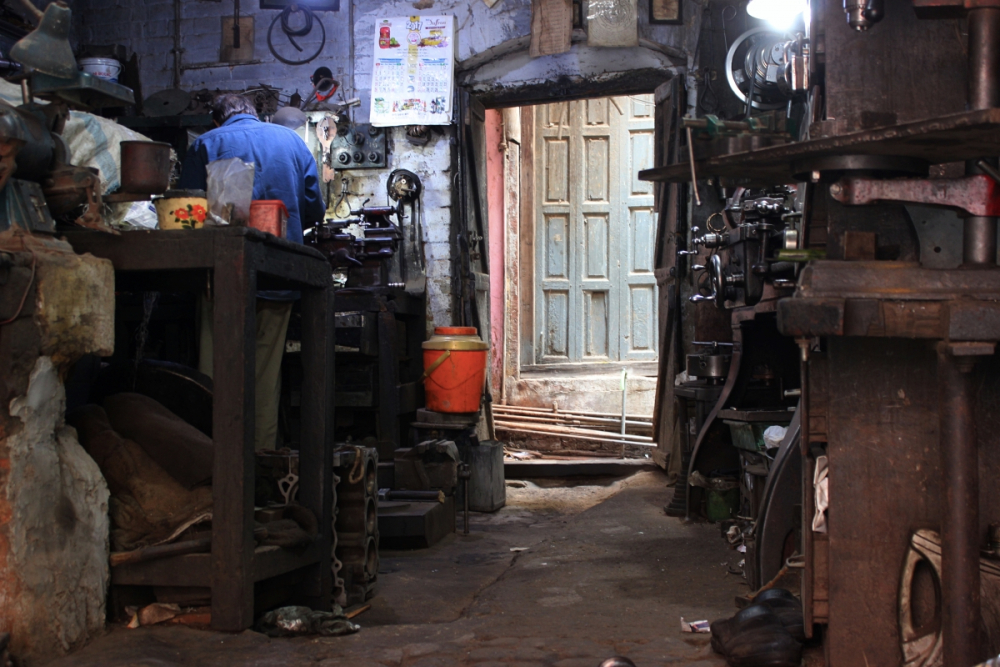
Small-scale industries
Most of the small scale industries and karkhanas (workshops) of Delhi were located within the ambit of the old city of Delhi before Partition, for what is now the old city was Delhi itself not too long ago. Amongst the major karkhanas located at Lal Kuan were those that dealt with metal, including the work of dhalayi (moulding) and kherad ka kaam (finishing and repairing of metal products). The work of kherad principally entailed the finishing and repair of metal tools and machinery.
The Bharat Motor Repairing Works today is run by two brothers, Abbas Ali and Arham Ali, who inherited this workshop from their father and belong to a family from the lohar biradari who have been dilliwalas for more generations than they can count. Kaleem Hasan Siddiqui, the third main worker in the workshop has worked with them long enough to be considered the third brother.
Owing to the traditional culture of oral storytelling in their biradari, Abbas Ali can recount much of his family history in detail, history that he would not know about if it weren’t for the stories that his phuppi (paternal aunt) narrated. Their early Muslim ancestors, shares Abbas (overcoming an initial hesitation that may be owing to the current political climate), came to India with the Mughals. Some were from Turkey while others were from Mongolia and were brought along with the fauj (army) of Babur who planned to settle in the subcontinent. At least that’s what our elders have told us, states Abbas. Our ancestors came and settled in north India thence and we have been living here ever since. Eventually part of what came to be known as the Muslim lohar biradari, our community did lohe se mutaalik saara kaam (all work related to iron) under the Mughals including working for the royal army. When the 1857 ghadar (revolt) took place, the ensuing large-scale persecution of the citizens of Delhi and the banishment of most Muslim families from their homes, their family was forced to flee and they ended up in the nearby village of Beri, one of the many villages including Jhajjar, Rohtak and Badli where their biradari sought refuge. Jab aman hua (when peace was restored), our family returned to Delhi sometime in 1870–75, Abbas continues. For a brief period after our return, some part of the community worked with firearms that were used under the British government and came to be referred to as bandookwale. While it was eventually banned in Delhi, some of our distant relatives based in Indore still deal with firearms and continue to be known thus.


The repair workshop that he bought was evacuee property whose former owners had left their machines and motors behind, perhaps having plans to return to Delhi
With the turn of the new century, in 1901, my father went to Bombay to train as a driver and mechanic, picking up the basic know-how and skills of automobile machinery. On his return to Delhi, he initially worked with Pearey Lal Motors firm as one of the first drivers in the city of Delhi and went on to open his own repair workshop near Novelty Cinema called National Motors, co-owned by his elder brother. It was only after years of training and experience that he ventured to buy his own karkhana and established Bharat Motors in its present form in the year 1948. Interestingly, the repair workshop that he bought was evacuee property that was auctioned by the government, and its former owners had left behind their machines and motors, including a Danish leit machine. Perhaps, it belonged to a family that had planned to return to Delhi once the post-Partition violence ceased but never got the opportunity to do so, like thousands of other families who met a similar fate.
The first car ran on an Indian road in the year 1897, and throughout the 1930s only imported cars were seen in India. During the 1940s, a nascent automobile industry emerged with Hindustan Motors’ Ambassador and Premier’s Fiat being the most popularly remembered vehicles. Following independence in 1947, the Government of India and the private sector launched efforts to create an automotive-component manufacturing industry to supply to the automobile industry. In 1953, an import substitution program was launched and the import of fully built-up cars began to be restricted.
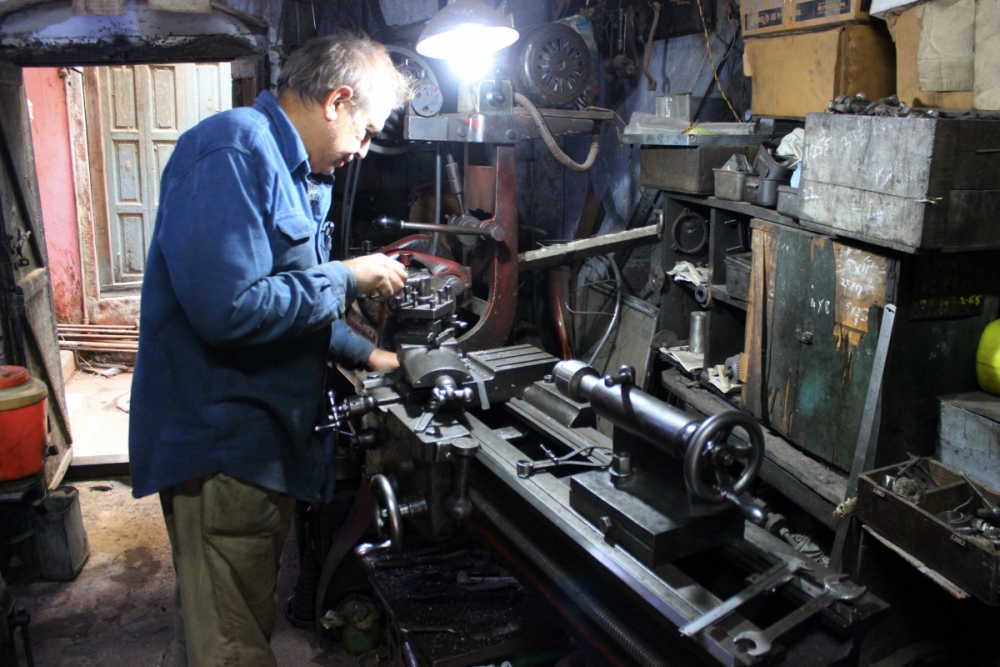
Though not formally trained, the engineers are supremely adept at their work and technically very skilled in the workings of foreign machinery
Throughout, from the first three decades of the 20th century when India’s automobiles were 'import only', to the time of assembly-only vehicles first put together in Bombay, up to the 1950s when the first automobiles were finally manufactured in India, one problem remained common, that of repair. Since most automobile machinery used was imported, when it came to repairing, it was very difficult and expensive to obtain specific spare parts of a machine especially of those machines that were only imported as wholes and not as parts. This meant that replacement wasn’t, in most cases, a feasible option. Thereby rose the demand for local mechanics. For all the repair work, these local mechanics were employed and whatever spare part was required, they would help make it. Though not formally trained, they were tremendously adept at their work and technically very skilled, having acquired the know-hows of foreign machinery without any formal tutoring. A lot of it was jugaad, agar purza nahi mil raha hai toh keel thok ke kaam chal sakta hai, Kaleem says laughing: if a spare part was not available, they could either produce a similar part, or make do with the kinds that were available—a very valuable and innovative skill of making existing things work, or creating new things with meagre resources. They have done contractual work with the Delhi Fire Department and have had multiple contracts with Delhi Municipal Corporation for motor repairing.

If a spare part was not available, they could either produce a similar part, or make do with the kinds that were available
It was not limited to road vehicles, Abbas expands, we used to fix even parts of airplanes. We signed a contract with the Indian Air Force in 1983, he says, it was a very prestigious job. They had come to us jab sabne haath utha liye (when everyone else had given up). It was a small radar aircraft project, a Russian model and we helped convert the engine that used to work on petrol, reengineered it to work with diesel. Since the machinery was imported from Russia, he continues, the problem was, if you needed something as small as a spark plug, you would have to buy the whole engine, which was not at all feasible for the government, and the Ministry of Defense was in a fix. We signed that project through some contacts and then those planes were used Kashmir se leke Jaisalmer tak, humare hi banaye hue engine set use hote the (from Kashmir to Jaisalmer, it was the engine sets made by us that were used). Now those planes are not used anymore, ab toh who khatam ho gaye. Par hamne apne mulk ka paisa bachaya hai, he adds with pride (we have saved our country).
Saleem Hasan Siddiqui, a resident of the old city, and someone who is very familiar with the work of lohe ke kheradi recalls an anecdote from his childhood. Our family used to live in gali gandakwali in Kishanganj near the old sabzi mandi and there used be a well-known kheradi called Ismail Mistri who used live near our house. He was old and he couldn’t walk anymore but big cars of both Indians and the British would sometimes come to fetch him. As children, we would ask with great curiousity where they were taking him and would find out that he was being taken to the airport at Safdarjung because an airplane was not working! The Safdarjung Airport was very busy during the World War II.
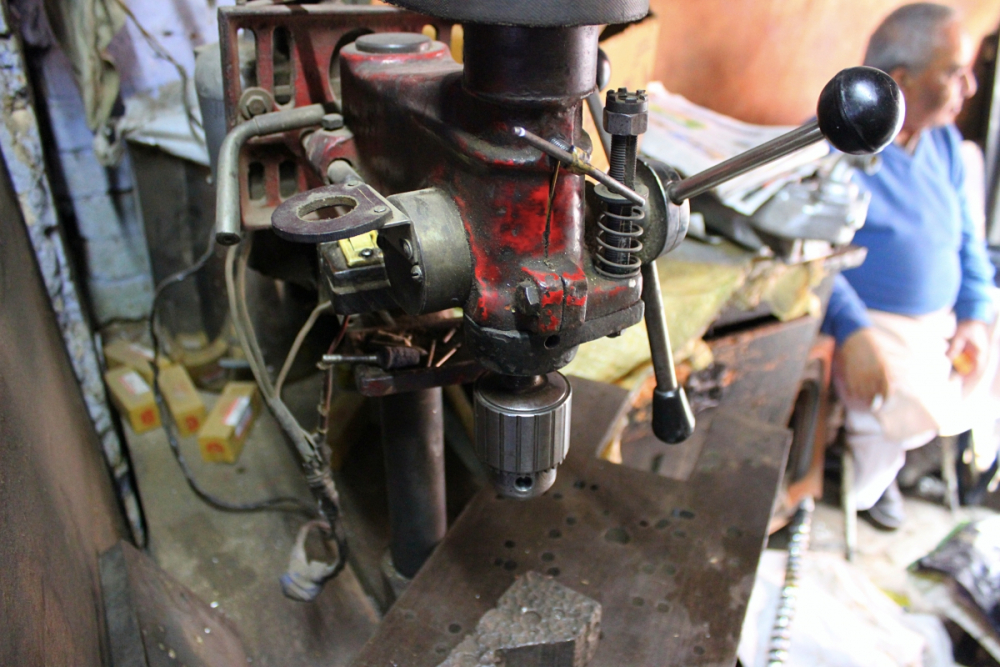

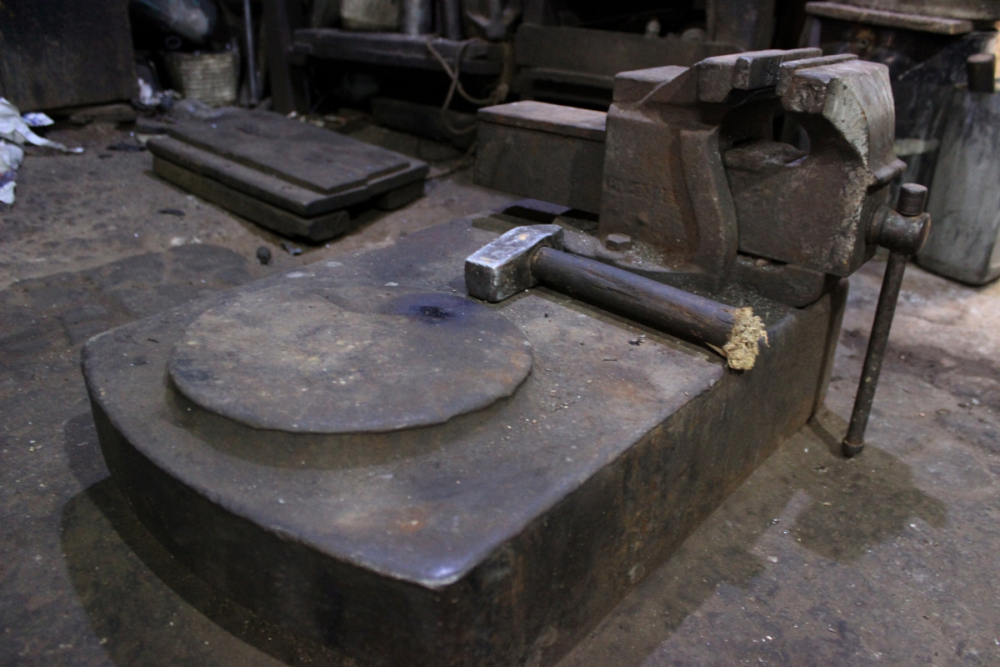
Four to five kinds of machinery are used in the workshop: an almost century-old Danish leit machine, a boring machine, drill machine, grinder and the crankshaft of a ship fixed to the floor of the shop
There are four to five kinds of machinery present in the workshop including an almost century-old Danish leit machine, a boring machine, a drill machine, a grinder and the crankshaft of a ship fixed to the floor of the shop. As mentioned above, the Danish leit machine and the ship’s crankshaft were already in the auctioned workshop, left behind by its previous owners. Casually pointing to some small motor parts on the table that escaped my narrow understanding of mechanics, Arham explained that they were Japanese, and they had successfully replicated them.
Former Delhi’s industrial area comprised small-scale industries and karkhanas (workshops) untouched by capitalist commercialization and catering mostly to local needs, all located within the ambit of what is now the old city of Delhi. The Partition of the subcontinent changed the trajectory of the city forever. With the post-Partition massive influx of refugees, Delhi grew at an unprecedented rate in all directions. As the city grew, it also witnessed an influx of migration from nearby states and the population of the city swelled. As the population of the old city also grew, the industrial units slowly began shifting outside to new industrial areas that sprung up outside the old city. Pointing outside his workshop in Lal Kuan, Arham Ali tells us that this whole area was packed with karkhanas. There were at least 30-35 workshops of lohe ke kheradi in this area and I’m only referring to the main road. There were many more karkhanas hidden in galis like Gali Shatare, Kucha Pandit etc. Karkhanas for dhalayi (moulding), motor repair work and even thateras (utensil makers) could be found here. He recalls even railway carriages being manufactured here. 'Our nana (maternal grandfather) had a very big workshop with machinery imported from England. But my mamu (maternal uncle) eventually sold the machines off one by one. Now only a handful of karkhanas for metal repair are left, only about five or eight. While most people shifted out as production costs in the city increased and the demand decreased, others took to retail shops selling hardware.'
With liberalisation opening the floodgates of imports in the 1990s, ending Nehruvian protectionist policies, the need for their work declined, and so did its value. Now that the automobile industry was growing at an unparalleled rate, so was the availability of spare parts as manufacturing in India increased. Besides, as more and more companies became part of the Indian market, commercial service centres also sprang up, further adversely affecting their work.
And as the karkhanas of dhalayi either shut down or moved out, the long-established chain between the manufacturing of machinery and their finishing snapped, and the costs of production shot up.
Besides, modernisation also brought with it the material culture that endorses replacement instead of repair. The ‘throwaway culture’ material culture of contemporary society, which discourages investment in repairing and encourages replacement, further propelled their decline. And the dizzying rise of the Chinese economy only consolidated this throwaway culture, for it became cheaper to buy a replacement than get the malfunctioning part repaired. Also, life has become so fast-paced, Kaleem adds, nobody has the patience to repair car machinery.

Now the Bharat Motor caters mainly to fixing and repairing vintage car machinery. Picture Source: 21 Gun Salute Rally
Now the Bharat Motor caters mainly to fixing and repairing vintage car machineries. Its prime customers comprise the South Delhi elite who own farmhouses in Chhattarpur and are vintage car enthusiasts. The owners of cars that are not manufactured anymore or cars whose parts are not available anymore come looking for them. Either the clients are old citizens of the city and are aware of the existence of the few old motor repair shops still functioning in the old city, or they are referred to these workshops by motor mechanics. A strong adherent of an old-world work ethic, Abbas talks of building a certain relationship with their customers that is based on trust (bharosa). One of their recent customers is Sandeep Kataria, a collector and passionate enthusiast of vintage automobiles and other mechanical items for whom they have just fixed the engine of a 1941 Rover. He deals with antique cars and is a well-known name in the 21 Gun Salute Rally, the annual Delhi NCR vintage car rally. Arham proudly shows me the fixed part of the Rover engine. He explains, that it has six cylinders, though they have experience of dealing with even with heavier engines with upto 12-16 cylinders. He says that some valves of the Rover engine were missing, and were available neither in the market here nor outside India as they are not manufactured anymore. But we fixed it, he finishes with pride. Perhaps in response to my clueless expression (giving away how technically challenged I am), he explains the valves to me using the metaphor of a human body. Our human body is like a machine that works by breathing in and out, similarly, a car engine also breathes in and out and valves are required for the breathing-in mechanism.
Will your children step into your shoes? Keh nahi sakte, broods Abbas. My son is currently working with the Indian Air Force as a technical mechanic. But I’m not sure if he will ever come work in this shop. Arham says his elder son has taken to other work while the younger one is still studying.
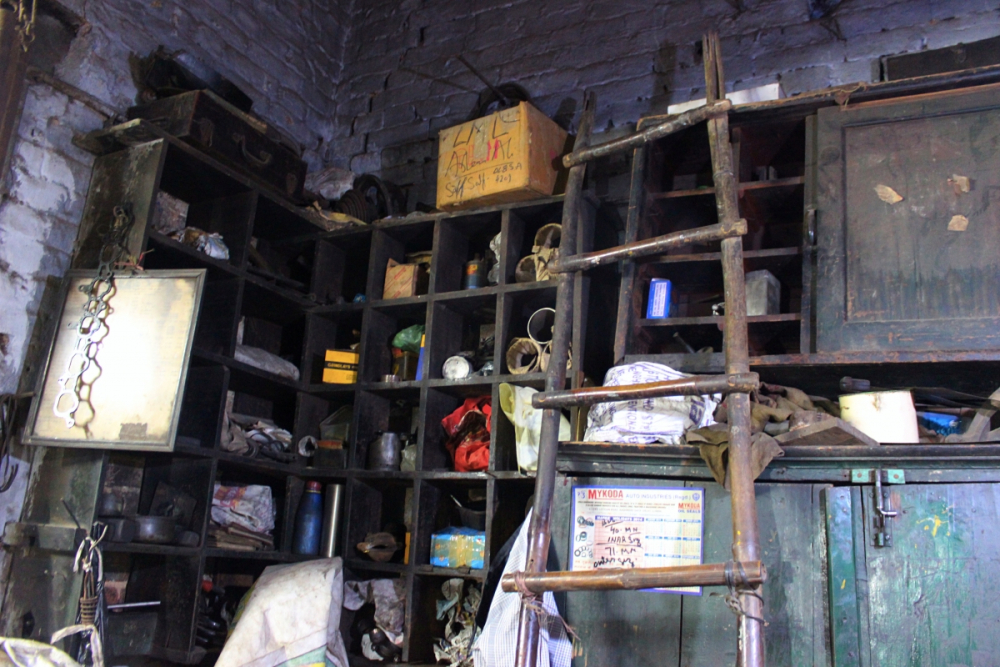
As the karkhanas of the old city disappear, it marks the loss of the industrial character of Old Delhi that was very much part of its historical landscape.
While motor repairing isn’t a profession that is representative of Shahjahanabad per se, nor is it a very old profession against the 450 years of Shahjanabad's history, kheradi provides an insight into how the old lohar biradari of Dilli adapted to changing needs, and its decline is representative of the decline of karkhanas of the old city, the shift of remaining metal industries from within the ambit of the old city to outside of it, and the replacement of manufacturing units with retail shops. And as the karkhanas of the old city disappear, it marks the loss of the industrial character of Old Delhi that was very much part of its historical landscape.













